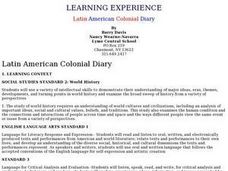Curated OER
History and Human Rights: A Process for Analyzing Events
Students analyze various American History topics which concern human rights. They research the topics and analyze the sources for bias or stereotype. They decide and discuss whether or not any human right were violated in each...
Curated OER
Corn Cob Toys
Students make toys from corn cobs. They study the many uses for corn, both historically and today. They write a description of the toy/object he or she has made and provide instructions for making it. They write and perform plays,...
Curated OER
The History of Money
In this social studies worksheet, young scholars investigate the history of paper money and coins. Students read paragraphs about what early people used for money and what kinds of banks were used. Young scholars complete a crossword...
Curated OER
Native American Homelands
Students discuss the Navajo, Sioux, and Iroquois tribes, noting their distinctive characteristics. They trace the homeland of each of the tribes on maps and create map keys. Students explain how they developed their map keys.
Curated OER
the World Rushed In: "Who Are These People? And How Came They Here?"
Learners discuss the struggles Californians dealt with regarding diversity brought about by the Gold Rush. They participate in a variety of creative, original activities and projects designed to reinforce the idea of historical diversity...
Curated OER
Native Knowledge
Students investigate what type of climate and physical features certain Indigenous groups live in using an atlas and a provided worksheet. They then match the tribe and its location to the sustainable stategy employed in agricultural...
Curated OER
Japan: Images of a People
Students learn the geography of Japan and its location in reference to the United States.
Curated OER
Latin American Colonial Diary
Students examine the class systems of New Spain. In small groups, they create a five-day diary about the family life, food, occupation, and government involvement of an assigned personality from the time of Colonial Latin America.
Curated OER
We the People (Cultural Research)
Fourth graders conduct cultural research, collect oral histories using tape recorders and cameras, and share their ancestral heritage with classmates through family heirlooms and ethnic foods.
Curated OER
Major American Water Routes
Sixth graders locate and identify the major bodies of water and waterways in the United States. Through a simulation activity, they describe how early explorers would have described their surroundings. Working in groups, they create...
Channel Islands Film
Once Upon A Time (Saxipak’a): Lesson Plan 1
As part of a study of the history of the Chumash on California's Channel Island chain, class members view the documentary Once Upon a Time, respond to discussion questions, and create a timeline for the different waves of migration.
Oklahoma City Public Schools Native American Student Services
A Story of Survival: The Wampanoag and the English
Redesign your holiday celebrations with the aid of a lesson plan booklet packed with facts, images, maps, activities, and readings about the three-day feast that marked the English settlers' first successful harvest.
Houghton Mifflin Harcourt
One Land, Many Trails: English Language Development Lessons (Theme 5)
English is not the only subject that requires its own set of vocabulary words—geography does too! A series of language development lessons designed to be used with Theme 5: One Land, Many Trails helps introduce readers to key vocabulary...
American Museum of Natural History
Tools of the Trade
Archaeologist David Hurst Thomas details his search for a lost Spanish Mission on St. Catherines Island, Georgia. A great way to introduce youngsters to the life of and the tools used by archaeologists.
School Rack
Westward Expansion Project Choices
What a great list of brief research projects for reviewing the era of westward expansion in the United States! Learners are directed to choose and complete three of the projects on the given list, which includes opportunities to design...
Read Works
First Thanksgiving Meal
Cranberries, oysters, lobster, deer, and cabbage were just a few of the foods found on the table at the First Thanksgiving. After reading a two-page passage about the historic meal, class members respond to 10 reading response questions.
Channel Islands Film
Natural Resources, and Human Uses of Plants and Animals
As part of their study of the restoration projects on Santa Cruz Island, class members demonstrate their understanding of the connections among plant life, animals, and the actions of humans by crafting a model that reveals these...
Student Achievement Partners
You've Been Lied To: The REAL Christopher Columbus
Looking for resources that explore alternative perspectives of the Christopher Columbus story? Check out the images, videos, cartoons, primary source documents, and other texts in a packet designed to spark debate.
Curated OER
Making a Report to President Washington
Young scholars gain an understanding of some of the challenges the U.S. faced at its birth. They are asked to compose a report on the state of the nation in 1790 (addressed to President George Washington), which includes a narrative,...
Curated OER
Masks
Students examine traditional masks from Southwest Indian groups and create their own mask based on Internet research. They share their mask with the members of their class.
Curated OER
Photography and the National Park Service
During the 1800s the United States was expanding westward; land was there for the taking. Kids explore how some early photographers used their photography to influenced the US Congress to save areas like Mirror Lake. They complete a...
Stanford University
Expansion of the Inca Empire
If you could write your own history textbook, what would you include? Learners play the role of textbook writers by examining evidence of the Inca Empire. With primary sources from Spanish and indigenous perspectives, as well as images,...
Curated OER
Foreign Miners
Pupils examine primary source documents from miners who went to California in the search of gold. They compare and contrast the letters they read and discuss what types of discrimination still exists today.

























